4 Types of Mulch You Can Use in Your Garden
Updated October 2021
If you ask any seasoned gardener their least favored part of gardening, you’ll likely hear the word “weeds.” Sure, we all will have to pull some weeds, but wouldn’t you rather prevent as many as possible?
To prevent weeds in a sustainable, non-chemical way, you’ll need to use a weed barrier. In my garden, and in most backyard gardens, that weed barrier is mulch.
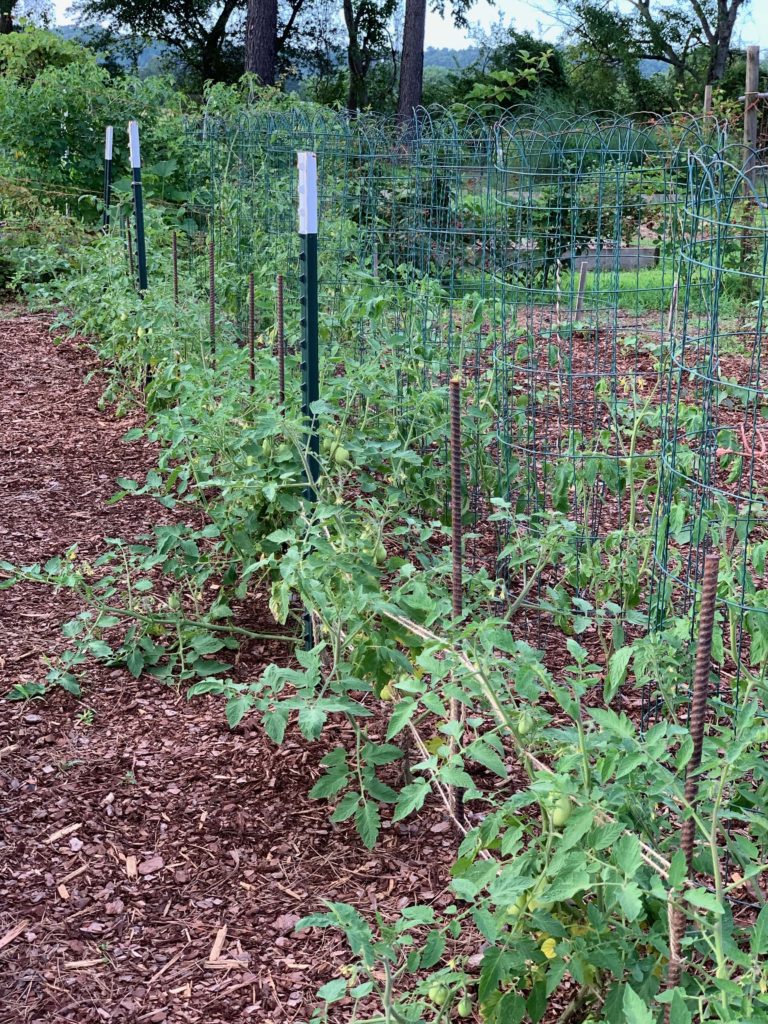
Mulch has many purposes. These are just a few of the main ones:
- It blocks sunlight, which inhibits the growth of unwanted weeds and grasses.
- It helps maintain moisture levels, which prevents water stress in times of drought.
- Natural mulch also breaks down slowly into the soil, depositing valuable nutrients for future plants and creating a habitat for beneficial organisms like earthworms, bacteria, and fungi.
The organic gardener has many choices in mulch, but over the years the ones I keep returning to are these:
- wood chips
- pine needles
- straw
- shredded leaves
Let’s explore the pros & cons of each of these types of mulch, and I’ll also mention why I no longer use hay as a mulch in my garden.
Wood Chip Mulch in the Garden
Wood chips are my favorite form of mulch. I’ve tried all the other methods below, but I always come back to wood chip mulch.
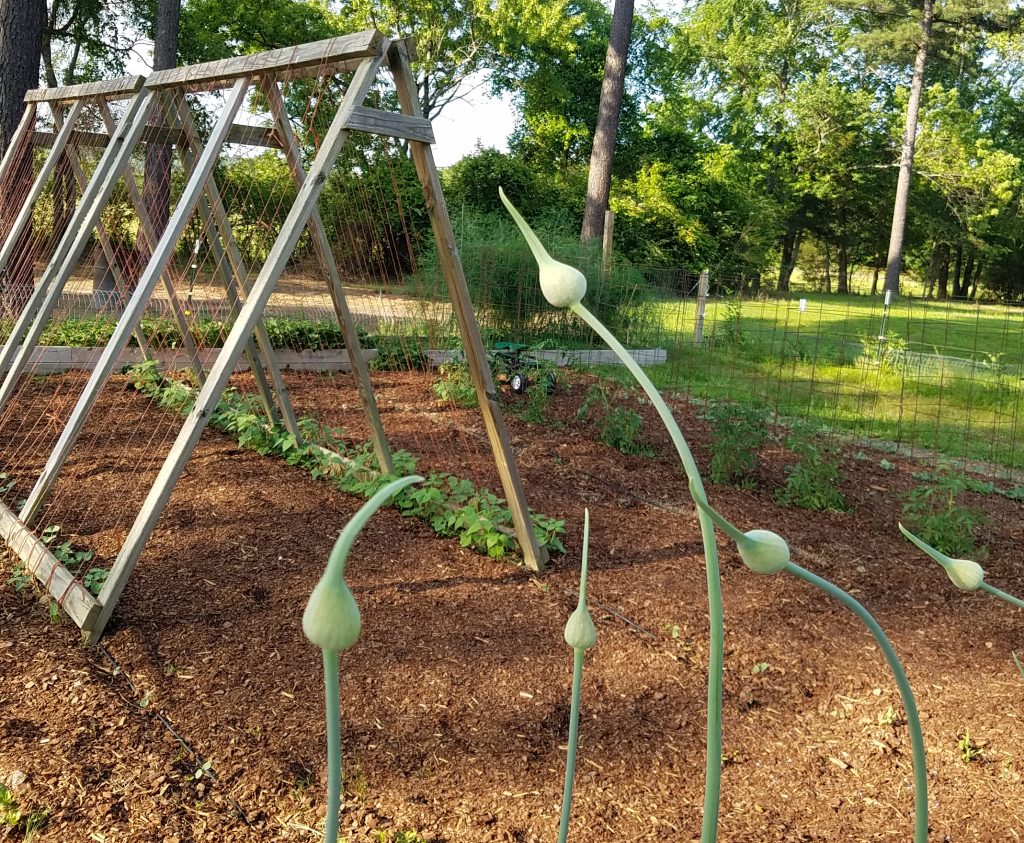
Benefits of Wood Chips as Mulch in the Garden
Free (potentially). I called my local tree service the summer before I began my first garden. When they were in my area, they were gladly willing to drop off dump-truck loads of wood chips from freshly-cut trees. If you don’t have time to wait for the tree service to deliver mulch to you, contact a your local municipality or a local lumber mill. Chances are you can obtain wood chip mulch from one of those places for free or for a small fee if you can haul it yourself.
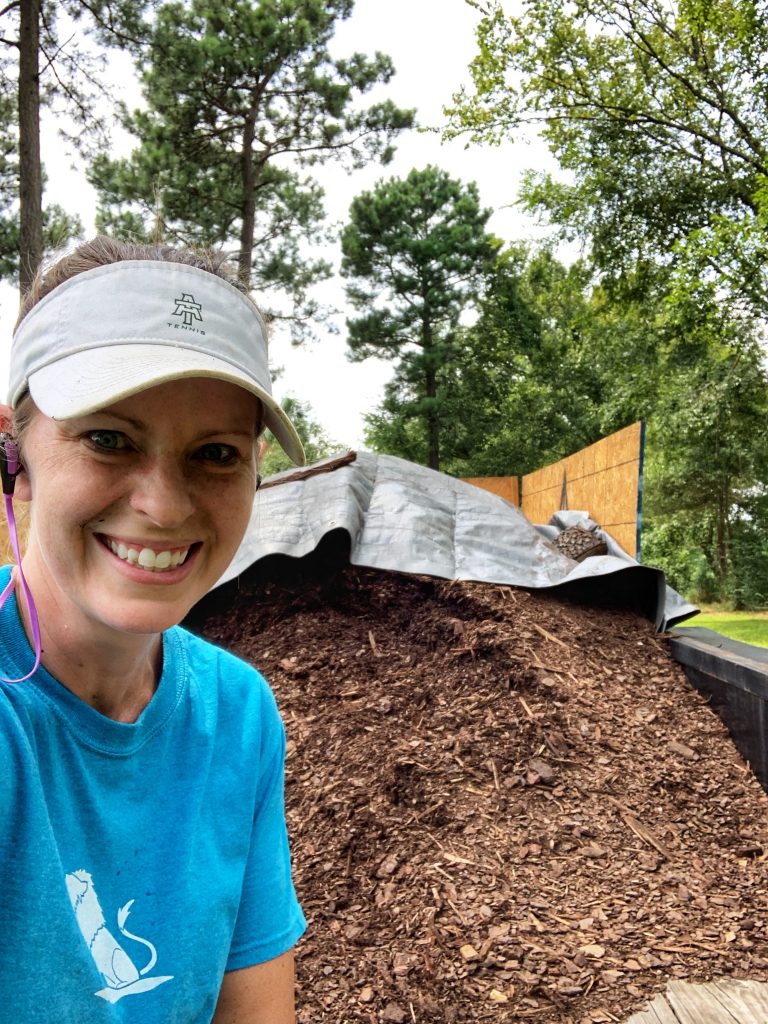
Beautiful. This is a personal preference, but I enjoy the beauty of a garden mulched with wood chips.
Easily handled. All you need is a pitchfork and a rake and you can lay down the mulch quickly and easily. It’s still work, don’t get me wrong. But laying down the mulch and smoothing it out is easy and maybe even a little therapeutic.
Improves soil structure. The parts of my garden covered with wood chips for multiple seasons have developed a lighter texture, which is a huge benefit for my clay loam soil. In addition, the wood chips contribute to soil fertility as they break down over time.
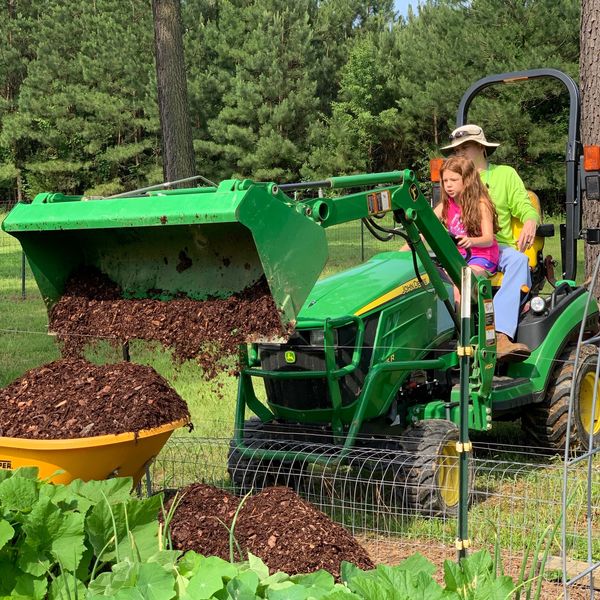
Drawbacks of Wood Chip Mulch in the Garden
Timing. You are usually at the mercy of when the tree service happens to be in your area.
Pest haven. Wood chips can be a haven for some pests, such as squash bugs. On the other hand, they’re also a haven for beneficial ground beetles as well If pests like squash bugs are a problem with your garden when using wood chips, avoid using wood chips in areas where their host plant (like squash) are growing.
Do Wood Chips Tie Up Nitrogen in the Garden Soil?
I’ve heard concerns that applying fresh wood chips to the garden will rob your soil of nitrogen that the plants need. This is commonly accepted as a garden myth these days (more on that here).
But here’s my personal experience after using wood chip mulch yearly for almost a decade: as long as I apply the wood chips to the surface of the soil, I’ve never had any issues with stunted plant growth. At the surface level, where the soil meets the wood chips, nitrogen will likely be used to help break down those wood chips, but at the root level, this will not be an issue.
As long as you do not incorporate (till, heavily rake) the wood chips into the soil (ever, even at the end of the season), you shouldn’t have any issues.
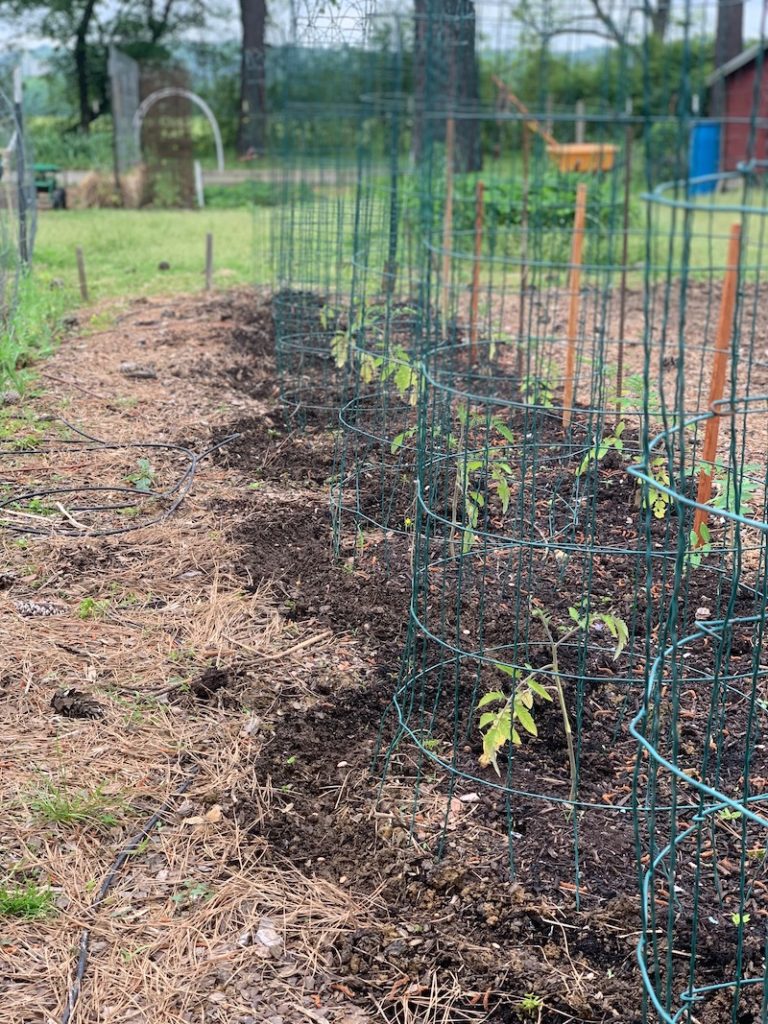
Pine Needles as Garden Mulch
I’ve used pine needles, also known as pine straw, off and on in my garden, simply because I have an abundance of pine trees on our property. Although they aren’t my preferred method, they do have their advantages.
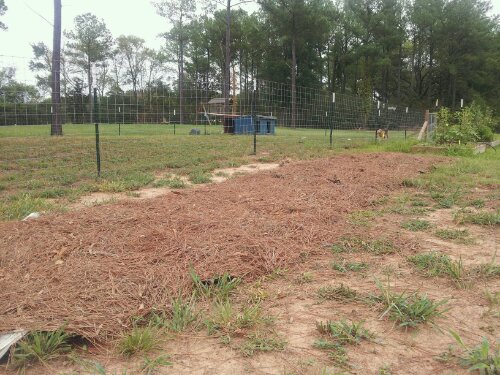
Benefits of Pine Needle Mulch
Free. If you live near pine trees, this is an obvious choice. In the fall when your lawn is covered in copper, rake the needles up and put them in a pile to sit over the winter. This is great exercise, let me tell you. (That’s my optimistic way of telling you this is a lot of work.)
Excellent barrier. Pine needles mat together easily, creating an excellent barrier. Once they are set down, they stay.
Slow breakdown. Pine needles won’t break down in one season like the other methods might. For this reason, I like pine needles on my walkways, which I keep constant from season to season.
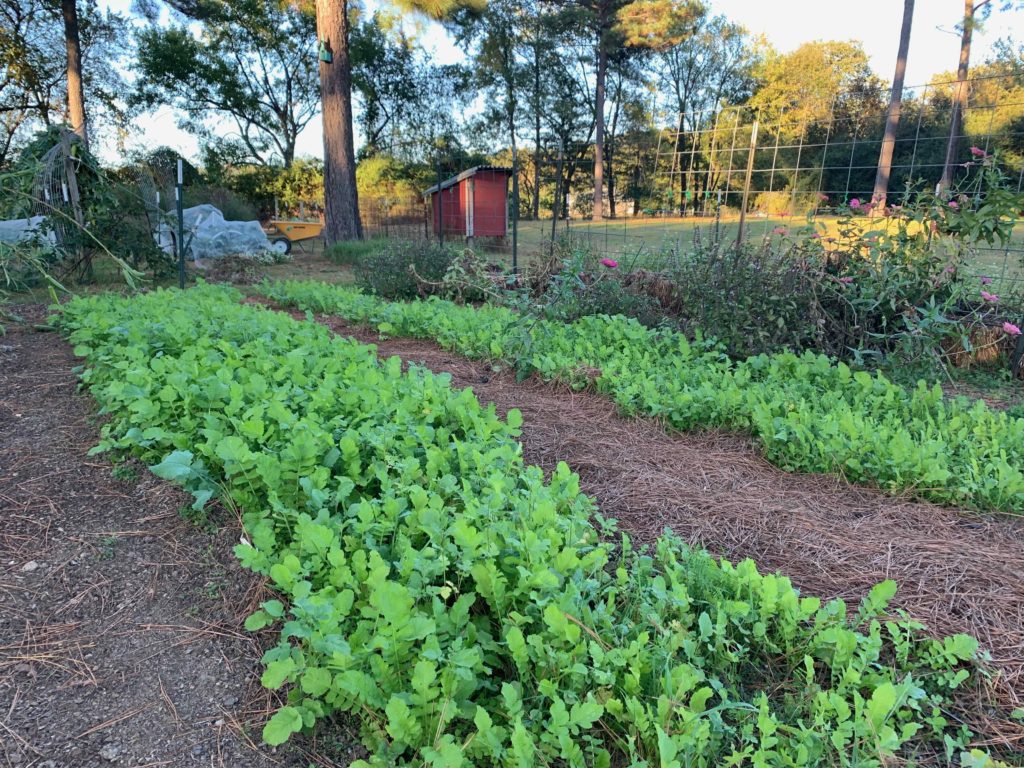
Drawbacks of Pine Needle Mulch
Not easily spread. Because of their nature, they aren’t as easily spread as other methods. They don’t take to raking across the garden like wood chips do, and they are a bit cumbersome to apply.
Physically prohibitive: If raking pine needles is your method of acquiring them, this can be a hard task for a large garden. However, for small gardens, it is easily doable.
Do Pine Needles Make the Soil Acidic?
Some people are concerned that pine needles could contribute to an acidic soil. Others, however, contend this is only true for fresh pine needles. The pine needles you’ll be putting on your garden are not fresh. I haven’t noticed a problem with even my naturally-acidic soil.
Shredded Leaves as Mulch
I began using shredded leaves more and more since I bought a leaf shredder and I began obtaining leaves from a family member’s property. After a year, I can say it has become one of my favorite mulches in the garden.

Benefits of Shredded Leaves as Mulch
Healthier soil. I personally found that the plants that grew in beds where I used shredded leaves were healthier and more productive.
Retains moisture. While this is an attribute of all organic mulches to some extent, I found it to be fantastic at moisture retention, a huge plus in dry times.
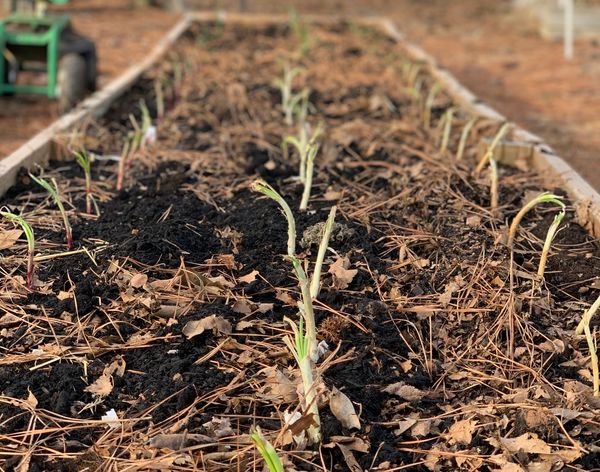
Drawbacks of Shredded Leaves as Mulch
Difficult to source. If you don’t have deciduous trees on your property, these may be difficult to obtain.
Can matte down, causing rot in some plants. Some plants, like strawberries, don’t love shredded leaves because of their ability to retain moisture, especially during rainy periods. Personally, I haven’t found this to be the case but I have heard others caution about it. I used shredded leaves on strawberries, garlic, asparagus, onions, and other crops with no problems.
They need to be shredded. If you don’t shred the leaves, they will blow away (ask me how I know). Many people mow over them and collect them, but I found the shredder to be well worth the investment.
Straw Mulch in the Garden
Straw is comprised of the stalks of a wheat crop. It’s easy to apply and easy to obtain. But I didn’t find it to be as effective at preventing weeds as other methods.
Straw is supposed to contain fewer weeds, but, I found more weeds deposited in areas where I used it (likely due to seed heads remaining in the straw bales).
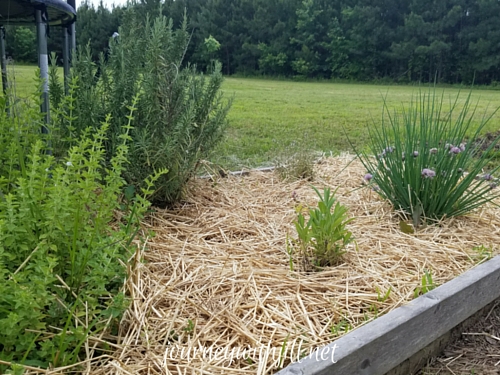
Benefits of Straw as Mulch
Easy to apply. Due to the density and length of the stalks in a bale of straw, I found straw much easier to apply.
Attractive. I still prefer my wood chips, but the shiny gold nature of straw lends an appealing look to a garden, especially in comparison to the dull look of hay.
Good choice for raised beds. Because of the cumbersome nature of applying pine needles, straw and wood chips were easier to apply in my 4′ by 8′ raised beds.
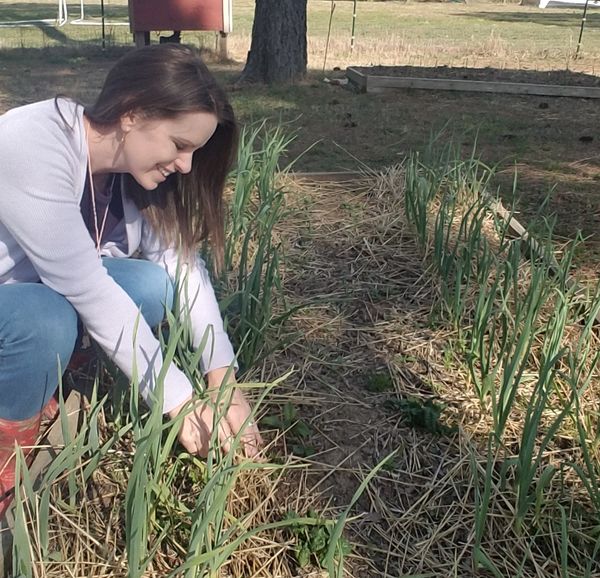
Drawbacks of Straw as Mulch
Hard to apply on a windy day. Because straw is so light, when applied on a windy day, it was hard to keep in place.
Less nutrient-dense. Straw is known to contribute fewer nutrients to the soil as it breaks down over time.
Not as effective as weed control. I use straw sparingly these days because I simply haven’t found it as effective as weed control. But it’s still one of my top options.
Hay Mulch in the Garden
Hay mulch is no longer one I recommend because unless you can find organic hay, the risk of poisoning your garden is too great (my experience was similar to this one). But if you can find a source of organic hay, it’s definitely an option to consider.
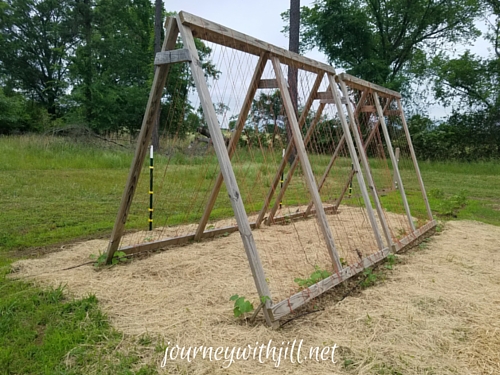
The year I used hay that didn’t poison my garden, it did an excellent job keeping weeds at bay. The only places weeds and grass got through was where I did not lay it on as thick. Here are some of the advantages I found.
Benefits of Hay as Mulch
Possibly free or cheap. If you know a farmer or can get your hands on spoiled hay, you’ll likely get this source for free or cheap. Otherwise, I bought my hay from the farmer’s co-op for $8 per bale. A bale goes a long way since it is rolled up tightly. One could easily mulch 3-4 raised beds.
Nutrient-rich. When hay breaks down into the soil it deposits a wealth of nutrients into the soil.
Excellent barrier. Matting down like pine needles, yet a little easier to work with, hay forms an excellent barrier for weeds. Although it is “puffy” when it is first applied, it quickly flattens, both to suppress weeds and provide a path on which the gardener can walk.
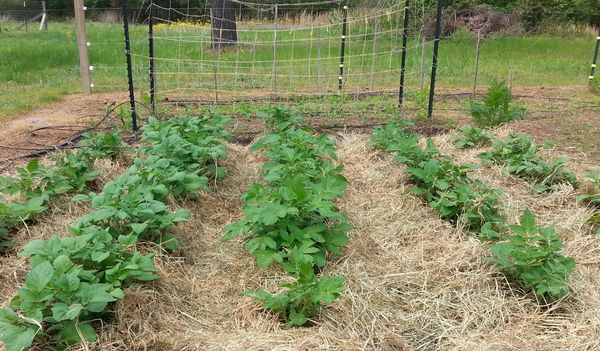
Drawbacks of Hay as Mulch
Cumbersome to apply. Although not as difficult as pine needles, it can be cumbersome to apply hay to existing crops. This simply means I can’t breeze through the task like with wood chips and straw. It just takes a little extra time.
Potential chemicals. From what I understand, almost all hay is sprayed with aminopyralid, so unless it’s organic, the hay probably has it.
Critter haven. Although I never found snakes in my hay, at the end of the season I did find voles. (At that moment I wished I had snakes to get rid of the voles.) Once I went back to wood chips, I never found voles in my garden again.
Which mulch will you choose in your garden?
Personally, after many seasons, I choose wood chips for the most effective weed control and its benefits in my garden. But I like using shredded leaves better for raised beds and pine needles for pathways.
But no matter which method you choose, the key is to apply it thickly. A layer 2 to 4 inches is ideal. If you find weeds or grass growing through it, apply more.
The main takeaway from this is simply to choose a mulch. Your garden will be more attractive, your work load will decrease with less weeding, and using one of these methods will over time allow your soil’s structure and fertility to be increased in the long-term.
What method interests you the most? Have you had experience with any of these?


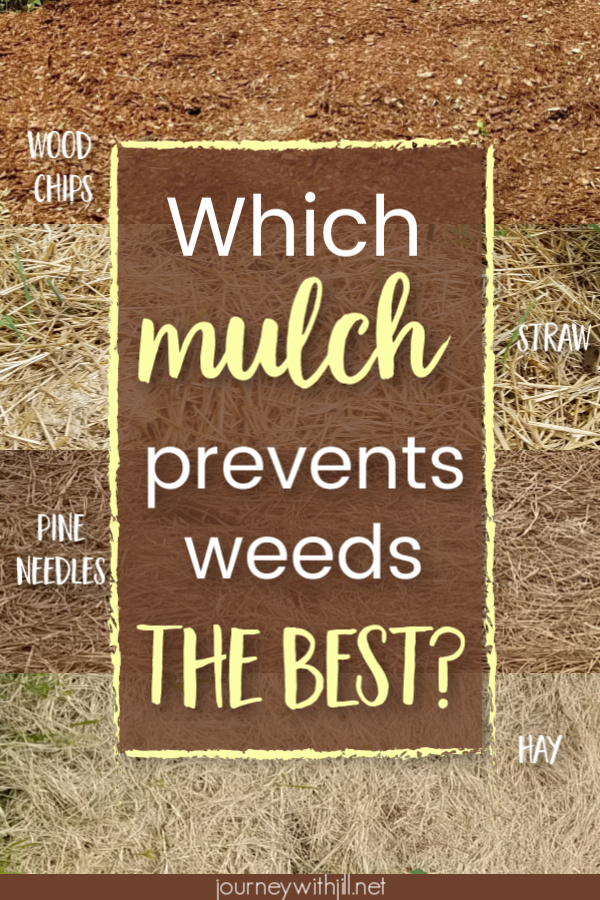
Hello Jill! I wanted to let you know I’m not able to download your recipes. When I click on the download I can only get two things to appear… No content available or a Subscribe to site that asks for first name and e-mail address. I entered my info on the Subscribe to Site page and it said I was already signed up for emails.
Patty, I’m so sorry for the incorrect link that was in your email. I just emailed you the correct link. Thank you for your patience!
I’m sorry. I didn’t get the email with the correct link. I checked and it didn’t go to my junk mail.
Hi Jill. We use pine shavings in our stables and I can get the used shaving for free. Would the shavings/horse manure mix be suitable as mulch?
Pine shavings mixed with manure are an excellent addition to your garden. I put them in my compost pile to let them break down a bit before putting them on my plants, but I think it’s worth trying it as a mulch, too. Just don’t mix it into your soil; let it break down naturally. That said, horse manure should only be placed on your garden if you’re certain the horses haven’t eaten any grass or hay treated with herbicides. I’ve heard horror stories of tainted horse manure killing a garden. But since they’re your horses you’ll have a good idea of what they’re eating.
Good morning Jill:
I purchased black colored mulch to act as a cover for my Dahlias. I like the dark colored bark as a background for the beautiful Dahlias. This is my first year trying this type of colored mulch. I’m concerned about the benefits or drawbacks. Some of the black Dye (?) came off on my hands.
I have never done any research on colored mulch. I personally don’t use it and wouldn’t on my edible food garden, but I wouldn’t have a problem using it with a strictly flower bed. I bet the contrast is beautiful with your dahlias!
Wondering what type of chips you use. Pine.
I’m not sure. When we buy in bulk, we get them from a local lumber mill, so pine would be a good assumption. When we get them from a tree service, I imagine there are lots of different types.
How do you plant rows of seeds if not tilling in the chips?
I rake aside the mulch temporarily. Then after the seeds have sprouted and grown to about 6″ high, I pull them back around the plants.
Would baled pine shaving work? I don’t have horses any longer but use the pine shaving on muddy paths so my dogs won’t track mud in the house. The baled shavings can be purchased at our local feed stores.
Possibly. I have never used that so I can’t speak to it personally. The only concern I’d have is that they might have the potential to get matted down in wet weather, causing mold and even preventing moisture to penetrate if it gets too matted. If that’s what you have on hand, I’d say to try it but watch out for those things. Also, don’t ever mix it into the soil (same with wood chips), as they will take nitrogen from the soil as they break down.
I have a question for putting mulch in my raised garden (I’m a newbie). Do I put mulch in the bottom as well as the top? So it would be mulch-soil- mulch? Or just at the top? How many inches of mulch do you want at the top for your garden?
I’m not sure that it’s necessary to add it to the bottom. If you’re thinking it would help with weed control, perhaps. Or look at something like cardboard boxes. (I’ve never done either… most of the weeds I’ve encountered were from existing weed seeds not due to them growing from the bottom.) Whatever you do, don’t mix it into the soil. As far as how many inches, I recommend 2 inches on top of the soil.
This may be a silly question – but would mulching a raised garden bed impact root vegetables that you have planted in it (radishes, carrots, onions, etc.). Thanks in advance!
Not negatively at all — at least not in my experience. In fact, I’ve noticed that my root crops, particularly onions, benefit from mulch because that mulch regulates the soil temperature. Onions will bolt with increasing heat, which happens more quickly in raised beds. Another thing is root crops don’t compete well with weeds, so mulching will benefit them by keeping the weed pressure down.
Hi Jill, what do you do with the wood mulch at the end of the season since you don’t till it with the soil.?
I have used salt (marsh) hay before and it was a good option because the seeds don’t sprout and it’s not treated. It’s not quite as pretty though And I’m not sure if it’s available around the country.
I leave it on the soil over the winter to break down. It helps prevent erosion, and you’d be surprised at how much of it actually does break down over the course of the year (I estimate 3/4 of it). Then, when it’s time to plant, I move the wood chips aside and then back around the transplant or seedling. Of course, by the next season, I have to add more.
Generally good comments but I wonder if you have experienced what happens to cardboard in or on soil after a short time. I did just that a while ago and then one day I was readjusting the soil and partly decayed cardboard. To my horror I had created a cellulose smorgasbord for all the termites in the area. I had created a magnet for these damaging little critters. Drop your guard a little and they do untold damage – especially if they get into a house
Interesting. I’ve never seen that, but I’ve also never looked underneath, as I’ve always just let the cardboard boxes decompose into the ground. My garden is also well away from my home; the only time we’ve had issues with termites is when using fresh wood chips next to the house. It’s definitely something to keep an eye out for, especially if a garden is close to a home. Thank you for pointing that out.
You didn’t mention grass clippings. Do you not recommend it?
Good question. I have never used grass clippings, which is why I didn’t include it; however, I do believe it’s a good option when used correctly. First, you have to make sure the lawn hasn’t been sprayed with any sort of herbicide. Second, don’t put fresh clippings on the garden, as they can matt-up and form a barrier of sorts in wet conditions. Let them dry out a bit and then sprinkle them on as mulch. I have a friend who has used them with great success.
What about leaf mulch? I’ve read that cut leaves mixed with grass (to add nitrogen) is an excellent mulch. What’s your take on this?
Absolutely! I didn’t include it in my list because I don’t have deciduous trees and personally haven’t tried it. BUT I know many gardeners use it as their primary source of mulch. You’re right to get it to a finer texture, and if you mix grass clippings with it, make sure the lawn hasn’t been sprayed with any pesticide or herbicide.
I enjoyed your article very much. My husband redid my raised bed, when I wasn’t home, and made it at least twice as big. I didn’t want bigger, just some new wood to replace what had deteriorated after many years! Learning to live with it. I would like to know what you think of cocoa bean mulch. Thanks.
I actually haven’t heard of cocoa bean mulch. I would assume any organic material that hasn’t been sprayed with herbicides/pesticides would be a good option for mulch, though.
Coca beans are excellent as a mulch and contain about 1% nitrogen, 1.5% phosphorus, 1.7% potash. They should be spread about 1 inch thick. This is according to J.R. Rodale in his book “The Complete Book of Composting.”
Just be careful of cocoa bean mulch if you have pets. It can be toxic to them.
I have inherited a garden with ground beds and the walkways are full of weeds, I have cleared all the beds by hand and can’t quite bring myself to do the same for the walkways. They are partially covered in leaf mulch currently. Would you recommend a layer of cardboard and then thin layer of wood chips? I have not heard of using cardboard like this before and have access to plenty. I am loathed to buy synthetic barriers if I don’t have too. Thank you!
Absolutely! That’s my preferred way to do it! I also use pine needles (they are abundant on my property) for the paths, since they’re free to me and they don’t break down as fast as wood chips. But I use wood chips, too. Just make sure you overlap the cardboard by 6-12″ to smother any pernicious weeds.
All of your information is so helpful. Easy to read and informative. I was wondering what kind of wood chips you find best to use as mulch? I use cedar on my walking paths between the beds, but have not used in my veggie beds. Is cedar the right choice of us there a more preferred kind of wood chips?
I have personally not used cedar wood chips, but from what I understand, they are fine to use as mulch (never till them in, as is the case for all wood chips). I have used both arborist wood chips and wood chips from our local lumber mill, both which have worked well in my garden.
Are pine bark nuggets or mini nuggets a good mulch for my vegetable garden? They take a few years to break down, so I assume I should remove them in the fall.
As long as they aren’t dyed, they should be fine. I don’t remove my wood chips in the fall. They will continue to break down into the soil, which is great for the soil. I rake the previous year’s wood chips (that are left) aside when planting the next season and then rake them back around the seedlings.
Don’t use wheat straw if anybody in your family has Celiac Disease.
for use of cardboard to put on the bottom of a raised bed is it good for drainage?
Yes, the water should still drain through the cardboard, especially as the cardboard begins to break down.
Hi Jill!
I’m new to raised bed gardening, and I just came across your website! So I apologize if you’ve answered this in another blog post, but if you don’t want your mulch mixed in at the end of the season, are you supposed to till up your garden bed at the end of the year or spring of next year? If so, would you then remove the mulch prior to doing so?
Also, that’s interesting to know about the pine needles! We put in raised beds because there are red pines directly over the best light in the yard. We were worried about the needles falling and making the soil acidic in the beds. Glad to hear the dead needles shouldn’t be too much of an issue on the acidity-front.
Thanks!
Chelsey
Hi Chelsey, I no longer till my garden, but if you do choose to till, I recommend raking back the mulch prior to doing so. I rake back my mulch prior to planting in the spring as well, to make sure to keep the mulch on top after planting. To address the tilling question you probably have — I have found that the more years I use a thick layer of wood chips, tilling isn’t necessary anyway, as the wood chips decompose and keep many weeds at bay. Now it’s just a maintenance thing to pull the comparatively few weeds that do get through. Tilling actually brings weed seeds to the soil surface, perpetuating the problem of weeds.
Will shredded paper work for mulch in raised bed? Around tomatoes and cucumbers
I haven’t used it, but I know people who do and it works well for them.
Hi,
If you use wood chips as mulch what do you do when the next year comes? Do you have to scrape it all out treat/feed your soil then put it back on?
Thanks
Chris
I keep the mulch on over the winter. Then I scrape it aside before planting (adding compost then) and then put the mulch back when the plants are about 6″ tall.
So last year my garden sucked. My husband wanted to till it up. I said give me one more year. (I have lots of flower bulbs in my garden growing between my veggies) I put all the fallen maple leaves on top then some lawn clippings added some steer manure then top soil. So far all my plants look healthier than ever and the worms are huge. I feel like the worms are tilling the garden for us. I am now going to try putting mulch like you said. Wish me luck 🙂
I’m a huge fan of not tilling, after I’ve seen effects like the ones you described. Good luck this season!
What do you think of rotating mulch through the seasons? Would this help the soil composition or does it not really matter that much?
I’ve never tried it, but it wouldn’t hurt. Any organic mulch that will break down will contribute to your soil fertility.
Hi! We used free mulch from our city street department in the vegetable garden this year. I also placed rectangles of cardboard at the base of my tomato plants to try to keep the rain splash from getting on the leaves. The cardboard is held in place by the tomato cage. I hope this lessens the chance of blight. Time will tell the story. Thank you for your blog. I enjoy reading it.
That sounds like a great plan!
what do you do with the wood chip mulch on the garden at the end of the year?
I leave it on to protect the soil and continue breaking down into the soil. When it’s time to plant the next season, much of it has already broken down, but what hasn’t, I rake aside before planting, then return after the plants are about 6″ tall.
Hi Jill. I enjoyed your article on mulch. My issue is I have a huge pile of pine tree mulch that has been sitting in the yard for at least 3 years. I had several pine trees cut down and they were mulched. I have used them on walkways and flower beds. Would the mulch be ok to use on vegetable, tomatoes, beans, cucumbers and peppers? I am so torn as whether to use it or not. I feel because it has sat so long it would be ok but just need some reassuring. Thank you some much for your time and experience b
If you’re referring to pine needles that have fallen from the trees, absolutely use them. I’ve used them several times and they do just fine. They don’t break down as fast as other methods, which can be a good thing.
My “native soil” is sand. What is best to mix with the sand or do you know of a sight that has experience with sand? I live in the south where it is hot and humid (I’m right by the water).
Also, what are you thought on carpet, especially in walkways?
How do you handle the plants (especially large ones like tomatoes) at the end of the season, include the summer plants before fall planting? Do you just cut them down to the ground level and leave the roots or do you pull the roots out and at what point do you do it?
I don’t have experience with sand, but from what I have read, it’s best to add compost. Epic Gardening has blog posts on this subject if I’m recalling correctly. I don’t have personal experience with carpet on walkways so I can’t speak to that. For your last question, it depends on the crop. If it’s for sure done for the year, I’ll pull it (cut it off at the soil-level to let the roots decompose into the soil). I’d rather make room for new crops than keep old ones. But if they’re still producing well, I’ll try to plant around them. Just depends. This 5-minute podcast episode helps explain what I do in more detail: https://journeywithjill.libsyn.com/qa-how-long-do-you-let-plants-stay-in-the-garden-before-taking-out
I have trees and a leaf shredder, so I use leaves as mulch. The tree companies cut down a lot of diseased trees, so I’m hesitant to use free wood chips. I don’t know of any tree companies personally, so I just stay away from that.
What do you think of cypress needles for mulch- are they too acidic? I have trees that drop a lot of needles in fall!.
I’m not familiar with cypress needles, but I use pine needles in my garden regularly. Though it was once thought pine needles would acidify the garden, that is no longer considered true. (Fresh pine needles, yes, but fallen ones, no.) I’ve been using them for 8 years and the pH of my soil hasn’t been affected negatively.
What about thermites in the wood chips?????
I’ve only experienced that once or twice and they really weren’t a problem as long as they were in the garden, away from the house. The one time I used arborist wood chips near my home, they got inside our house. But in the garden, which is far away from the house, they didn’t cause any problems.
Do you usually fertilize and put any kind of compost in the bed before you put the leaves? Is it ok to put the leaves as it is as I don’t have a shredder?
Most of the time, I do add a layer of compost first.
I’ve tried using leaves without shredding them, but they blew away. I’ve also heard that the larger leaves matte together and repel water, so I wouldn’t recommend laying freshly-fallen leaves on the garden bed without shredding or without allowing them to sit for awhile (to crumble a bit). Some people keep them in bags over the winter to break down and then lay them on in the spring if they don’t have a way to shred them.
What is your opinion of using coir for mulch? I was able to get some for a reasonable price and planned on putting it around a newly planted tree. I won’t need much so I was thinking of using it in my raised garden bed.
I’ve never used it. I’ve heard it can be salty, which can affect seed starting, but I’m not sure that would make a difference as a mulch or not.
I want to rake up my grass clipping ect for mulch or just under the soil of my raised bed but am worried about all of the weed seeds and foliage that must be in it. I dont know how to “heat it up in compost” or anything. It sounds time consuming.
If you don’t want to research and go to the trouble of learning how to hot compost (I never have), you can always put them in a pile and let them sit for a few weeks. Once they’re good and brown, you can turn it up and start watering. If there are any viable weed seeds they’ll sprout and you can decide if they are numerous or not. If there are just a few, it’d be easy enough to turn (to dislodge the roots) or cover with a tarp (to kill them) and do it again. All that said, I’ve never used grass clippings, but when I hear from those who do, they never mention it being weedy in the garden. The biggest risk is if the grass has been treated with any chemicals.